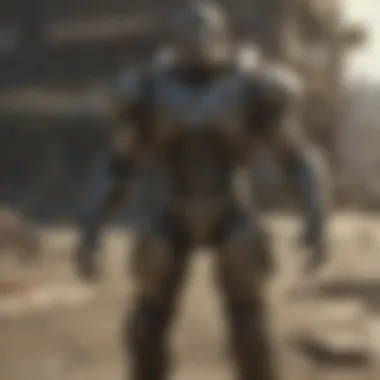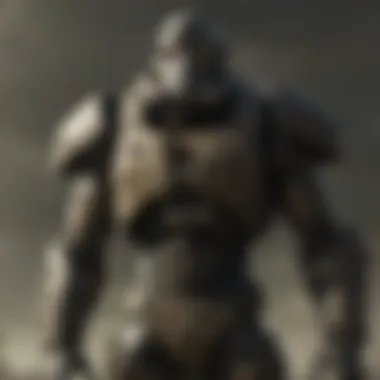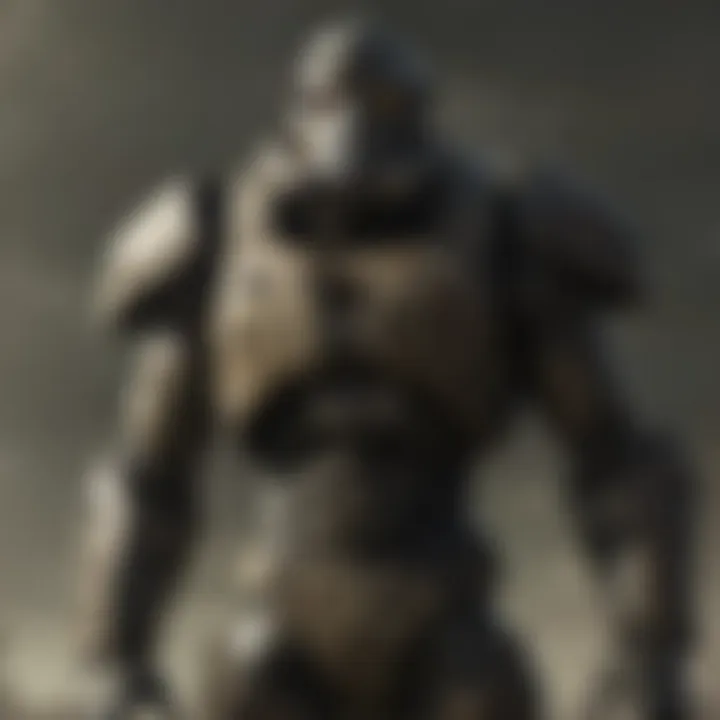Exploring Fallout 4: Game of the Year Edition Features


Intro
Fallout 4: Game of the Year Edition has reignited the flame for fans of the series, serving as a gateway to both nostalgia and new adventures. This enhanced edition doesn't just slap on some shiny graphics; it brings a comprehensive experience that invites players to dive deeper into the Wasteland. With an enriched narrative, robust gameplay changes, and additional content, it reshapes how one interacts with the sprawling post-apocalyptic universe.
This article explores various facets of the Game of the Year Edition, from historical lore that enriches gameplay to strategies that can tip the scales in favor of the player. Whether you're a long-time inhabitant of the Commonwealth or a fresh wanderer, there will be insights to keep even the most seasoned player engaged.
Lore Insights
Overview of the Fallout Universe
The Fallout series stands out in the gaming landscape, intertwining a unique mix of alternate history and dark humor. Born from a post-nuclear world where society has crumbled, players become part of a universe filled with mutated creatures, rogue factions, and the enduring question of morality in a lawless expanse. Fallout 4's setting, the Commonwealth, epitomizes this chaotic blend, showcasing remnants of a once-proud cityscape, now overrun by dangers and secrets.
Key historical events in the Fallout timeline
Historically, the events leading up to the apocalypse shape the gameplay and storyline. Here are critical moments that leave a mark on the game:
- The Great War (2077): A quick and devastating nuclear exchange between global powers that obliterates civilization.
- The Construction of Vaults: A preemptive government response, housing citizens under the pretense of safety, while masking more sinister experiments.
- Rise of Factions: As society collapses, various groups like the Brotherhood of Steel and the Institute emerge, each claiming a piece of the new world order.
Deep dive into the backstory of major factions and characters
The compelling narratives of factions such as the Minutemen and the Institute provide countless hours of gameplay. The Minutemen, with their altruistic mission to help others, stand in stark contrast to the secretive, technologically superior Institute. Each faction's backstory is flavored with rich history, grappling with questions about freedom and the ethics of technology.
For an enlightening perspective, "Each faction is like a piece of a shattered mirror, reflecting different aspects of humanity's choices post-apocalypse," as noted by a passionate community member on Reddit.
Gameplay Tips and Strategies
Beginner's guide to playing Fallout games
the Fallout series isn’t just about shooting your way through enemies. It's also about choices and their repercussions. Here are some tips for newcomers:
- Explore Thoroughly: Take the time to loot every nook and cranny. You may discover valuable items or even hidden quests.
- Dialogue Matters: Conversations can often lead to unexpected outcomes or rewards depending on the choices you make.
- Build Relationships: Certain characters can aid you in battles and share unique quests based on your rapport with them.
Weapon and armor recommendations
In the Commonwealth, survival hinges upon your arsenal. Some solid choices include:
- The Deliverer: A silenced pistol effective for stealth missions.
- The Laser Musket: For those who appreciate a bit of flair with their firepower.
- Combat Armor: Provides a sturdy defense, especially against raiders.
Tips for efficient resource management
Resource management is vital. Keep these strategies in mind:
- Scrap Everything: You’d be surprised how even the smallest item can provide valuable materials.
- Stay Hydrated and Fed: Starvation and dehydration can hit hard, especially in the tough climates of the Wasteland.
- Use Workshop Stations: Crafting can drastically improve your supplies and upgrade weapons or armor.
Character Analysis
Detailed profiles of iconic characters
Characters in Fallout 4 breathe life into the storyline. Each one carries their share of motivations and histories:
- Piper Wright: A fiercely loyal reporter who believes in revealing the truth.
- Preston Garvey: The determined soul of the Minutemen, relentlessly working towards rebuilding communities.
Relationships between characters in the Fallout series
The dynamic connections between characters can significantly shift your path. For instance, the clash between factions often enforces moral dilemmas, compelling players to choose sides and navigate complex relationships.
Character development and evolution across games
While Fallout 4 centers on individual stories, it also acknowledges past events and characters from previous titles. The evolution from rigid archetypes to more layered personalities encapsulates the franchise's growth.
News and Updates
Latest announcements from game developers
Fallout 4's Game of the Year Edition has come with its fair share of buzz. Developers have hinted at future content updates and community engagement initiatives through major platforms. Regularly check the official Fallout 4 updates page for the latest news.
Patch notes and upcoming releases
Stay informed regarding the changes and improvements reflected in patch notes. These adjustments not only enhance gameplay but also fix lingering bugs, further refining your experience.
Community events and tournaments
Engagement with the Fallout community is alive and thriving. Annual tournaments and events provide fans an opportunity to showcase their skills and connect with others who share a love for the franchise. Check platforms like Facebook for community updates.
Fan Theories and Speculations
Popular fan theories about the Fallout universe
The world of fan theories around Fallout is vast. Some speculate on how different games interconnect in ways that are not explicitly stated, while others delve deeper into hidden meanings behind character choices and outcomes.
Discussion on unresolved plot points
Among the millions of discussion threads, certain plot points remain shrouded in ambiguity, leaving room for endless debate among fans.
Predictions for future installments in the series
Fans are always pondering about what’s next for Fallout. With each new game, players hope for more intricate storytelling and enhanced world-building, keeping the spirit of Fallout alive.
"Fallout is a mirror to society, presenting a dystopia that's all too real, yet impossibly surreal."
In closing, Fallout 4: Game of the Year Edition is an expansive realm filled with stories waiting to be explored. Each layer, be it character, lore, or gameplay, adds depth to a post-apocalyptic world that’s anything but simple.


Prelude to Fallout
The world of video games has birthed numerous universes, but few stand out like Fallout 4. This game is not just another installment in a long line of post-apocalyptic role-playing games; it embodies a refined blend of storytelling, exploration, and combat mechanics that keeps players coming back for more.
Understanding Fallout 4 is crucial for appreciating the Game of the Year edition, as it builds on a legacy rich with humor and tragedy. The title's ability to engage players through its intricate settings and dimensional characters is remarkable. Here’s why diving into its introduction matters:
- Foundational Lore: It sets the stage for understanding the broader narrative context of the game, allowing players to grasp the implications of their decisions in the Wasteland.
- Gameplay Mechanics: By discussing initial mechanics, readers can appreciate enhancements made in the Game of the Year edition. This edition polishes and adds layers to the gameplay experience, warranting discussion about its origins.
- Cultural Impact: Fallout 4 isn’t just a game; it’s a phenomenon. Recognizing its initial impact helps contextualize its influence in the gaming industry and fan culture.
Here's a glimpse of what this section holds:
- Setting the Stage in the Wasteland
- Release History and Initial Reception
This journey begins with piecing together the shattered remains of society, providing an avenue into the heart of Fallout 4, where every choice echoes in the desolate beauty of its universe.
Setting the Stage in the Wasteland
Upon stepping into the Wasteland, players find themselves in a vibrant world that simultaneously exhales beauty and despair. The landscape, littered with remnants of a bygone civilization, evokes a sense of exploration and discovery. The juxtaposition of ruined cities and untouched wilderness invites players to venture forth, igniting an intrinsic curiosity.
The environment is more than just a backdrop; it’s a character itself. Each location tells tales of survival, loss, and adaptability. For instance, roaming through the bombed-out remains of Boston, players can snag a glimpse into lives once lived, now reduced to graffiti and lore scattered across the ruins. The diversity in biomes—including crumbling urban landscapes and desolate zones—further enriches this experience, enabling players to confront the realities of a shattered world.
Moreover, the Wasteland breeds engagement. With various factions intertwined in a struggle for power, players encounter a spectrum of moral dilemmas, furthering the theme of survival in the harshest conditions.
Release History and Initial Reception
The launch of Fallout 4 marked the culmination of years of anticipation. Released in November 2015, this title was quickly met with a wave of excitement. The marketing blitz preceding its release built up a sizeable community eager to experience the rich world that Bethesda Game Studios had promised.
Upon its debut, Fallout 4 received critical acclaim for its expansive open world and engaging storyline. Players were particularly drawn to the game’s ability to provide a sense of choice—the feeling that each decision could rewrite the rules of their survival.
However, it wasn’t perfect. The initial reviews highlighted certain drawbacks, such as bugs and performance issues that some players faced on specific consoles. Nevertheless, the praise for its depth and scale overshadowed these complaints, leading to favorable ratings across multiple platforms.
"Fallout 4 is a grand leap forward for the series, even if it trips now and then—a desire for survival reigns supreme."
This examination of Fallout 4’s release history also acts as a prelude to understanding its Game of the Year edition. This enhanced version demonstrates a commitment to refining the core experience while also expanding upon it, offering a fuller picture of the Wasteland and the stories residing within.
What is Fallout 4: Game of the Year Edition?
The notion of Fallout 4: Game of the Year Edition is pivotal in understanding how the franchise has evolved and how this specific release resonates with both veterans of the series and newcomers. With its myriad of expansions and patches, the Game of the Year Edition encapsulates the essence of a journey that begins with an engaging storyline and leads to an immersive experience through its DLCs and updates. By collecting the base game along with its extensive downloadable content, players are offered a more comprehensive view of the Commonwealth. This edition not only enriches the narrative but also allows a broader exploration of the mechanics that have become the hallmark of the fallout series.
Features of the Game of the Year Edition
From the get-go, the Game of the Year Edition of Fallout 4 is packed to the rafters with value. Here are some notable features:
- All DLC Packages Included: This edition comes with all previously released downloadable content. Each DLC, from Automatron to Nuka-World, provides unique quests, new weapons, and characters, allowing players to delve deeper into the wasteland’s lore.
- Survival Mode: An added layer of challenge, this mode not only ups the difficulty but also demands that players consider hunger, sleep, and other survival essentials. This change alters the very texture of gameplay, creating a stark difference from the standard experience.
- Graphical Enhancements: While the original Fallout 4 was already visually appealing, the Game of the Year Edition introduces polished graphics that elevate environmental immersion. Improved lighting and textures create a more tangible and atmospheric wasteland.
- Quality of Life Updates: The release ensures smoother gameplay with various bug fixes and performance improvements that enhance overall user experience. This includes refined user interfaces and adjustments in interaction designs, making the game more intuitive and responsive.
- Community Integration: With the inclusion of modding support officially recognized by Bethesda, players can access a broader range of community-created content, which can add significant replay value.
Differences Between Standard and GOTY Editions
When assessing the standard version of Fallout 4 against the Game of the Year Edition, several differences leap out. For those keen on maximizing their gaming experience, here are the main distinctions:
- Content Accessibility: The GOTY edition offers all DLCs in one package. For someone who purchased the standard version before the DLCs, that may mean additional costs and fragmented experiences as they acquire these expansions separately.
- Gameplay Mechanics: The introduction of the Survival Mode in the GOTY version alters how players strategize about mission completion. Standard players enjoy a more straightforward approach, while GOTY users must navigate a complex web of survival tactics.
- Improvements and Updates: Updates to mechanics and the graphical overhaul present in the GOTY version offer an enhanced experience that the base game does not possess. This can make a considerable difference in missions and the canonical feel of the wasteland.
- Community Engagement: The GOTY edition fosters a more robust community engagement through modding capabilities not as seamlessly integrated in the standard release; players looking for personalized experiences may find this to be an appealing factor.
The increase in accessibility and enhancements provided in the Game of the Year Edition makes it a formidable entry point for new players and a convincing upgrade for longstanding fans of the franchise.
Detailed Look at the Content
The downloadable content (DLC) in Fallout 4: Game of the Year Edition expands the already rich narrative and gameplay, offering experiences that feel both refreshing and essential. Each DLC not only adds new quests and environments but also deepens the existing lore and player engagement. The importance of exploring this content lies in understanding how it enriches the overall fabric of the game, providing players with new avenues to explore, new stories to uncover, and the ever-important crafting and combat enhancements that come with each expansion.
Automatron: A New Dystopia
In Automatron, the world is introduced to a new layer of complexity with the inclusion of robotic foes and allies. The story kicks off when a mysterious Mechanist sends an army of killer robots into the Commonwealth. Players are thrust into a narrative that encourages them to both combat these machines and eventually join forces with them.
This DLC is significant for several reasons:
- Crafting Mechanics: Automatron allows players to salvage parts from defeated robots to create their own companions. This ability to personalize allies is a game-changer, giving a fresh twist to character development.
- Exploration of Morality: The theme of technology versus humanity is explored deeply, and delving into player choices in how they interact with these machines provides a thought-provoking layer to the gameplay.
- Combat Enhancements: New weapons and armor can also be crafted, opening up diverse strategies for players in battles against both robots and human foes.
Wasteland Workshop: Building Tomorrow
Wasteland Workshop takes the player's experience from survival to creation. This DLC introduces an obsession with construction, allowing players to capture creatures and build arenas for battle. Players essentially turn into architects of their own little corners in the wasteland.
Key elements include:
- Customization: The ability to create settlements gets a boost. Players can craft various trap types and even choose how to engage with the captured creatures, influencing their settlements’ ecosystem.
- Engagement with the Environment: It adds a layer of interaction with the barren world, making the wasteland feel less desolate and more full of life.
- Strategic Gameplay: This content allows for creative strategies, especially when setting traps for enemies or capturing wild beasts.
Far Harbor: High Stakes in a Foggy Environment
Far Harbor transports players to a new location, shrouded in mist and mystery. It centers around a missing person quest that spirals into a web of intrigue involving synths, the Children of Atom, and the people of Far Harbor itself.
The importance of this DLC can be seen in its:
- Rich Storytelling: This expansion delves into the ethical implications of synth existence, pushing players to make critical decisions that affect the fates of various factions.
- Exploration of Atmosphere: The dense fog and eerie environment not only set a gothic tone but also challenge players' navigation skills.
- New Foes and Allies: Encountering new characters and enemies adds depth to player interactions and opens up different tactical approaches.
Nuka-World: An Amusement Park Gone Awry
Nuka-World offers players a unique twist on the traditional wasteland by introducing a dilapidated amusement park and funhouse horrors. Players become the raider leader in a place that was once a symbol of joy and entertainment, now turned into a battleground.
The highlights of this DLC are:
- Faction Leadership: Unlike previous DLCs, players must navigate loyalty and power dynamics among different raider factions, which challenges preconceived notions about morality and leadership.
- Vibrant Yet Creepy Environment: The whimsical yet horrifying atmosphere of Nuka-World is unlike anything found in previous locations, allowing players to explore a barrage of themes from nostalgia to despair.
- Combat Variability: It introduces new combat scenarios in fun but challenging settings, enhancing the player experience in unexpected ways.
In summary, the DLC content available in Fallout 4: Game of the Year Edition enhances the core game by not only expanding gameplay mechanics but also enriching its narrative fabric. Each piece of content stands out, yet they collectively deepen the emotional engagement with the game, ushering in a new era for players to delve further into the post-apocalyptic world.
Exploring Gameplay Mechanics


In the vast, desolate expanse of the Wasteland, gameplay mechanics serve as the very backbone of the experiences that players can immerse themselves in within Fallout 4: Game of the Year Edition. These elements not only enhance player agency but also deepen the engagement with the narrative and environment. At its core, gameplay mechanics bring about a sense of realism and personalization, which is vital for constructing meaningful interactions within a world that feels both relentless and inviting. This section aims to dissect the significant components of gameplay, highlighting how each aspect contributes to the overall experience that Fallout 4 offers.
Character Customization and Development
Character customization stands out as a hallmark of Fallout 4's charm. From the very beginning, players are encouraged to craft their unique survivor, giving them the chance to manipulate facial features, body types, and gear. The S.P.E.C.I.A.L. system—referring to Strength, Perception, Endurance, Charisma, Intelligence, Agility, and Luck—lets players decide how their character will evolve. Each attribute influences gameplay in its own unique way. For instance, a character left heavily weighted in Charisma can charm factions and NPCs, drastically altering quest lines and alliance possibilities.
Benefits of Character Customization:
- Personal Connection: Creating a unique avatar fosters a sense of investment and emotional attachment.
- Diverse Playstyles: Each player can approach challenges according to their build, making every journey unique.
- Replayability: Different attributes and choices lead to different endings and interactions, encouraging multiple playthroughs.
Whether you're gearing up for some stealthy takedowns or engaging in diplomatic negotiations, how you build your character can transform your Wasteland journey.
Combat Systems: Old and New
Combat in Fallout 4 presents an engaging blend of familiar mechanics and fresh innovations. While the V.A.T.S. (Vault-Tec Assisted Targeting System) remains a staple for tactical shooting, the game also emphasizes real-time combat, pulling players into the action in a way that feels distinctly more immediate. Armed with an arsenal ranging from improvised melee weapons like a baseball bat to high-tech rifles, players must adapt to various combat scenarios.
One significant shift is the ability to trigger V.A.T.S. in real-time, which allows for a seamless blend of strategy and chaos. This mechanic can turn the tide in the heat of battle, allowing players to target specific limbs, which is particularly useful against formidable foes and adds layers of strategy to combat encounters.
"In the Wasteland, one bullet can mean the difference between survival and becoming just another skeleton on the road."
Combat Features:
- Diverse Weapons: The variety of weapons allows players to tailor their approach according to their play style.
- Dynamic AI: Enemies adapt to player tactics, requiring constant adjustment in strategy.
- Environmental Utilization: Players can use the environment to their advantage, employing obstacles for cover or setting traps.
Crafting and Resource Management
Crafting is where creativity and practicality converge in Fallout 4. The game allows players to gather a plethora of resources scattered throughout the Wasteland, encouraging exploration and rewarding players for scavenging. This mechanic opens up innovative pathways for enhancing weapons or building settlements.
Salvaging materials from the ruins—be it scrap metal or circuit boards—empowers players to modify their equipment to fit their needs. Understanding how resources interconnect can create some of the most powerful gear in the game. Additionally, establishing settlements brings in another layer of resource management. Players can design their strongholds, create supply lines, and manage their settlements to thrive in a hostile world.
Key Aspects of Crafting and Resource Management:
- Settlement Building: Players can create and manage settlements, adding layers to the gameplay.
- Crafting Unique Items: The ability to customize weapons and armor fosters creativity.
- Resource Optimization: Efficiently managing resources becomes essential for survival in the Wasteland.
By combining these mechanics, Fallout 4 encourages an engaging loop of exploring, crafting, and engaging, ultimately crafting a narrative that unfolds uniquely with each player's choices.
Narrative Depth and Themes
In the realm of video games, narrative depth and thematic exploration can elevate a simple pastime into a profound experience, and Fallout 4: Game of the Year Edition exemplifies this notion exceptionally well. The game intertwines engrossing storytelling with complex characters and moral dilemmas, pulling players into a post-apocalyptic universe. These narrative elements are not just background noise; they shape player choices, drive interactions, and impact the overall gaming adventure.
Fallout 4 operates on a multi-layered narrative framework that fosters a sense of player agency. The choices made throughout the game possess weight, often leading to unforeseen consequences. This aspect encourages players to immerse themselves deeply, as the world reacts dynamically based on their decisions, creating a personalized tale. The duality between survival instincts and ethical decisions serves as a poignant reminder of humanity's fragility in the face of disaster.
Main Storyline Analysis
The main story of Fallout 4 revolves around the search for a kidnapped child, Sean, and the quest for answers amid a ravaged world. Players step into the shoes of the Sole Survivor, awakening from a cryogenic sleep in a devastated Boston. The initial experience sets the stage for a gripping narrative. Players navigate through a landscape dotted with remnants of pre-war society while grappling with the changes wrought by the Great War.
Key plot points unfold through interactions with the Institute, a shadowy organization embroiled in technological advancements and moral ambiguity. By engaging with various factions, including the Brotherhood of Steel and the Railroad, players face choices that can drastically alter the course of their story. Furthermore, this interplay of intention and morality highlights essential themes, such as the cost of progress and the definitions of humanity.
- The emotional weight carried by the Sole Survivor fuels the narrative, making the stakes personal.
- Players often confront their motivations, blurring the lines between right and wrong.
- The recurring theme of family, represented through the search for Sean, resonates strongly in character interactions and emotional arcs.
Side Quests and Their Significance
In Fallout 4, the main storyline is enriched by a wealth of side quests, each carrying its own narrative threads and thematic depth. These quests allow players to traverse beyond the central plot, offering a more expansive view of the Wasteland’s complexities. The side quests not only enhance the lore of Fallout but also provide an outlet for character development and exploration of moral quandaries.
Each side quest contains nuanced storytelling that often challenges the player’s ethics. For instance, the quest "The Silver Shroud" invites players to step into a vigilante persona, raising questions about justice and its implications in a lawless world. Similarly, quests such as "The Castle" delve into the themes of community and reclamation while examining the potential for rebuilding in the face of adversity.
- Side quests often reveal the lives and struggles of inhabitants, adding depth to the game’s world-building.
- They confront players with dilemmas, challenging their moral compass and inviting reflection on broader societal issues.
- Engaging with the quests enhances the player's affinity with characters and the universe, turning the experience from simple engagements to meaningful connections.
"A non-linear narrative allows players to shape their stories while revealing the intricate tapestry of life in the Wasteland."
As such, the narrative depth of Fallout 4: Game of the Year Edition stands as a remarkable testament to storytelling within gaming. With its compelling plotlines and moral challenges in both main and side quests, players don’t merely observe a story—they live it.
Visual and Technical Enhancements
Visual and technical enhancements play a crucial role in the overall gaming experience of Fallout 4: Game of the Year Edition. As players venture into the vast and desolate post-apocalyptic landscape, the quality of visuals can significantly affect immersion. These enhancements breathe new life into the already rich environments and character designs, making the experiences not only nostalgic but visually captivating as well.
The aim of these upgrades is not merely aesthetic. They forge an engaging atmosphere for exploring the intricacies of the world, from the crumbling buildings in Diamond City to the eerie fog that envelops Far Harbor. Enhanced graphics and performance allow us to appreciate details that may have slipped under the radar before, like the subtle textures on NPC clothing or the majestic glow of a sunset filtered through the haze of a nuclear wasteland.
Graphical Improvements in the GOTY Edition
In the Game of the Year Edition, graphical improvements have made significant strides. Improved lighting techniques, high-resolution textures, and reworked animations all contribute to visually stunning environments. The landscapes feel more alive; shadows appear more realistic, and water reflections are more dynamic. Every corner you turn feels different, creating a sense of discovery.
For instance, during certain quests, the aesthetic changes based on weather conditions can heighten the emotional impact of key narrative moments. Picture yourself in the middle of a tense encounter, the dark clouds gathering above, and the world becoming drenched in rain. This kind of detail draws you into the storyline, allowing for a deeper connection not just with the characters and quests, but with the world itself.
"Visuals are not just about looking good; they are about storytelling without words. Each graphical upgrade adds layers to the narrative, giving the player a more immersive experience."
Technical Optimization and Performance
Technical optimization is another aspect that sets the GOTY Edition apart. While many players might gloss over it, the stability and smoother frame rates provided by these enhancements can’t be overstated. The game's performance modifications mean less stutter during action-heavy segments, where every second counts. For those who engage with the game’s crafting systems or base-building mechanics, a fluid user interface is paramount.
These optimizations allow a seamless flow from one activity to another, for instance, transitioning from combat to exploring base mechanics. The reduced load times and minimized glitches can significantly alter how players interact with the world.
When comparing the Game of the Year Edition to earlier versions, it becomes clear that the developers have painstakingly worked on refining the gaming experience. This dedication to enhancing the visual and technical aspects ultimately ensures we receive a polished title that is worthy of both old fans and new players entering the world of Fallout.
Community Reception and Critique
Understanding the community's reception of Fallout 4: Game of the Year Edition provides valuable insight into the game's legacy. Gamers are not just passive consumers; they actively shape the narrative surrounding a title. Their feedback and engagement can uncover the many facets of a game that developers might not notice.
This section delves into how players received the game, weighing its strengths and pitfalls while also discussing the importance of community feedback in evolving gaming experiences.
Reviews and Scores Overview


The Game of the Year Edition was met with a generally positive response from critics and players alike. Review scores painted a rosy picture, often landing in the mid to high 80s out of 100. Publications like IGN and GameSpot commended the vast amount of content and enhancements in this edition. Here’s a summary of what they highlighted:
- Enhanced Graphics: Critics noted the graphical upgrades that offered a refreshed visual experience.
- Expanded Content: The inclusion of all DLCs in a single package allowed new players to dive into the complete experience from day one.
- Immersive World: Reviewers repeatedly stressed how the Wasteland felt alive, filled with quests that felt both meaningful and engaging.
However, not every note was harmonious. Some reviews pointed out that the base game had retained its share of bugs which somewhat marred the experience for some players. In their detailed look, Kotaku expressed that while the advancements were praiseworthy, fixing the existing glitches should have been a priority.
"The world is immersive, yet it is frustrating when you hit a wall glitch or see NPCs behave oddly, breaking the realism."
These reviews created a well-rounded picture, showing both the awe of returning to Fallout’s landscape and the disappointment with lingering issues.
Fan Feedback and Modding Community
The true heartbeat of many Fallout titles lies not just in the official game but in the creativity and passion of its community. Fans were vocal about their experiences with the Game of the Year Edition, often sharing their thoughts on platforms like Reddit and forums.
Many players were excited about the modding potential. The modding community flourished post-release, with a myriad of mods popping up that enhanced graphics, added new quests, or fixed bothersome bugs. Some notable mentions are:
- Enhanced Lighting Mods: These drastically improved immersion in the Wasteland at different times of the day.
- New Quest Lines: Several mods introduced quests that expanded on existing characters or story arcs.
- Quality of Life Improvements: Mods that streamlined inventory management or rebalance certain gameplay aspects received significant praise.
However, just like the mixed reception from critics, fan feedback had its share of critics. Some argued that despite the enhancements, the essence of fallout was lost in translation. Community discussions often centered around the sentiment that, while the new content was delightful, the core gameplay was in desperate need of innovation.
In summary, the community's reception of the Game of the Year Edition reflects a blend of satisfaction and frustration. Players appreciated the enhancements and additions, yet the bugs remained a persistent shadow. Understanding this interplay of response not only emphasizes the importance of player feedback but also signifies a call to developers to listen and adapt, ensuring the franchise retains its formidable grip on its audience.
Comparative Analysis with Other Fallout Titles
The world of Fallout is expansive, intertwining narratives, unique gameplay elements, and a rich lore that captures the imagination. In this section, we will explore how Fallout 4: Game of the Year Edition stands in relation to its predecessors like Fallout 3 and Fallout: New Vegas. This analysis is essential to understanding not just the Game of the Year Edition, but also the evolution of the franchise itself.
Contrast with Fallout
Fallout 3 was a pivotal entry in the series, marking the transition into a fully 3D open-world experience. In that iteration, players navigated the Capital Wasteland, discovering its depth through a compelling main storyline juxtaposed with memorable side quests. The strengths of Fallout 3 were its atmosphere and the foundations it laid for future titles.
Fallout 4 took what made Fallout 3 shine and decided to expand it, audaciously reshaping the landscape of gameplay mechanics. One of the most significant contrasts lies in character customization. While both games allowed players to design unique protagonists, Fallout 4 took it several steps further with advanced crafting systems and enhanced dialogue trees, giving players more freedom to mold their experience.
Additionally, the introduction of settlements in Fallout 4 brought a new layer of strategy and creativity that was absent in Fallout 3. Players can build and manage their own safe havens, developing a relationship with the land in a way that emphasizes survival. These innovative features showed the developers’ intent to carve out a fresh identity for this title while still respecting the legacy of its forerunner.
Tie-In with Fallout: New Vegas
Also noteworthy is Fallout: New Vegas, often hailed for its rich storytelling and player agency. Unlike Fallout 3, which leaned more on linear narratives, New Vegas encouraged players to engage with intricate factions and moral dilemmas that greatly influenced the game's outcome. Its focus on dialogue and character interaction set a bar for narrative depth.
Fallout 4 shares similarities with New Vegas in that it maintains a focus on choice, yet it makes a distinct departure by implementing a more action-oriented combat system. The gunplay in Fallout 4 is notably improved, which resonates with players looking for a more visceral experience amid the post-apocalyptic setting.
Another ties between them is their shared world-building ethos. Both titles excel in allowing players to explore desolate yet rich environments filled with lore. However, the ambition of Fallout 4 lies in attempting to blend these elements seamlessly within its own framework, including settlement building and crafting mechanics that cater to a different type of exploration.
In summation, analyzing Fallout 4 in relation to its predecessors provides insights not only about its gameplay and narrative but also about the directions the franchise has taken. Players can appreciate the roots of the series while engaging in new experiences that follow. The legacy of past titles is crucial for understanding what Fallout 4: Game of the Year Edition offers: a bridge between the traditional core of Fallout and the bold steps toward modern gaming expectations.
"The true strength of any sequel lies not just in its ability to mimic what came before, but to innovate while giving a nod to its roots."
This analysis reveals that the evolution within the Fallout series is a dance between nostalgia and progress, something that Fallout 4 executes with a commendable finesse.
Legacy and Impact of Fallout
Fallout 4 has carved out a significant niche in the gaming landscape since its release. More than just another entry in the Fallout franchise, its legacy is framed by innovations in gameplay, storytelling, and design philosophy. The changes wrought by this title have rippled through the industry, offering lessons in narrative depth and world-building that remain relevant today. The impact of Fallout 4 is not merely about its commercial success; it's about how it has reshaped expectations for video games at large.
Influence on Future Bethesda Titles
When developers at Bethesda Game Studios set to work on projects following Fallout 4, the lessons learned from this title were clear. One cannot ignore how the refined crafting system, complex character progression, and improved AI behaviors influenced the development of future games.
- Refined Crafting: Building on what Fallout 4 introduced, the crafting mechanics evolved. Players enjoyed a more integrated experience where resource management became a cornerstone for survival.
- Character Progression: The flexibility in character development set a new standard. Players could not only shape their character's abilities but also determine their strengths based on personal choices.
- Dynamic NPC Behavior: Artificial intelligence saw a notable upgrade, with NPCs exhibiting behaviors that adapt based on player actions. This development spurred more immersive experiences in subsequent titles such as Starfield.
"Fallout 4 showed us that players engage more deeply when given the tools to alter their environment and storylines freely."
Lasting Effects on Open-World Design
In the realm of open-world games, Fallout 4 has left an indelible mark. The expansive map, filled with enriching quests, diverse environments, and immersive lore, has become a template for subsequent titles. Its design decisions paved the way for future developments in open-world mechanics, emphasizing player agency and exploration.
- Increased Immersion: Fallout 4 encouraged a sense of realism in an otherwise fantastical setting. Attention to detail, from environmental storytelling to dynamic weather systems, raised the bar for what players expect in open worlds.
- Player Agency: Decisions made by the player had tangible impacts on the game world. This has influenced other developers to create games where choices matter, leading to more personalized gameplay experiences.
- Environmental Richness: The post-apocalyptic landscape of Fallout 4 is filled with layers of history, secrets, and surprises. This set a standard for future titles to create rich, detailed worlds that go beyond mere aesthetics.
Culmination and Final Thoughts
In wrapping up this exploration of Fallout 4: Game of the Year Edition, it's clear that this edition stands as a testament to the ever-evolving landscape of gaming. The enhancements and expansions in this version do more than simply polish what was already there; they introduce a richness and depth that breathe new life into the experience.
The significance of this topic touches on several critical elements. First, it emphasizes the importance of understanding how narrative and gameplay mechanics integrate to create an immersive world. This edition not only gives players more tools and content but also allows for a more profound interaction with the wasteland's many stories.
When we evaluate the gaming experience as presented in this edition, we see a clear effort to engage both new players and veterans of the series. The additional storylines from DLCs compel players to dive deeper into the rich lore. The refinements in graphics and mechanics heighten the stakes, making each encounter feel more significant.
"Fallout has always been about choices, and this edition amplifies that experience, allowing gamers to shape their adventure further than ever before."
Moreover, the community's reception plays a crucial role in shaping the dialogue around Fallout 4. Fan feedback encourages developers to continue pushing boundaries, exploring new themes, and creating content that resonates with diverse audiences.
Ultimately, recognizing the importance of this edition sets the stage for future discussions about not just Fallout but the broader realm of open-world games. With each iteration, the game evolves, ensuring it maintains its relevance in an ever-changing industry.
Summation of the Gaming Experience
Taking stock of the gaming experience provided by Fallout 4: Game of the Year Edition, one is struck by the sheer scope of possibilities available to players. The game succeeds in painting a post-apocalyptic world that feels alive and just waiting to be explored. Each quest, whether main or side, contributes to a larger tapestry of narratives that highlight personal struggle, moral dilemmas, and the quest for survival in a harsh environment.
Players have the chance to engage in intricate character development. For instance, the S.P.E.C.I.A.L system allows players to tailor attributes that fit their playstyle. This leads to a multitude of playthroughs, showcasing aspects that might be overlooked in a more linear approach.
Additionally, the added content from DLCs like Far Harbor and Nuka-World provides further avenues of exploration. The fog-laden mystery of Far Harbor plays beautifully with suspenseful storytelling, drawing players into tough decisions. In contrast, the chaotic fun of a post-apocalyptic amusement park in Nuka-World injects a sense of humor, juxtaposing the otherwise grim reality of the wasteland.
As players wrap up their journeys through this enhanced edition, they're not just finishing a game; they're navigating a world filled with choices and consequences that resonate long after the console is turned off. They are participants in a story that is as much theirs as it is the game's.
The Future of the Fallout Franchise
Looking towards the future, the legacy of Fallout 4: Game of the Year Edition offers a glimpse into what may come next for the franchise. The rich world-building and narrative depth seen in this edition likely influence Bethesda's approach to future titles, including potential installments or spin-offs.
The developers have shown a commitment to listening to community feedback and incorporating it into their designs. This symbiotic relationship means that future expansions might delve even deeper into the lore and emotional weight that fans have come to cherish.
Moreover, as gaming technology continues to advance, there's potential for Fallout to evolve in unexpected ways. Innovations in graphics, AI, and even storytelling mechanics could lead to experiences that feel even more immersive. The solar-punk themes in gaming could provide a sharp contrast to the current post-apocalyptic settings, offering players a chance to envision a brighter future through gameplay.
Ultimately, the Fallout franchise stands at a crossroads, and the popularity of the Game of the Year Edition showcases a demand for more elaborate storytelling and a diversified gameplay experience. The future beckons, and with it comes the tantalizing promise of further adventures in the Wasteland.







